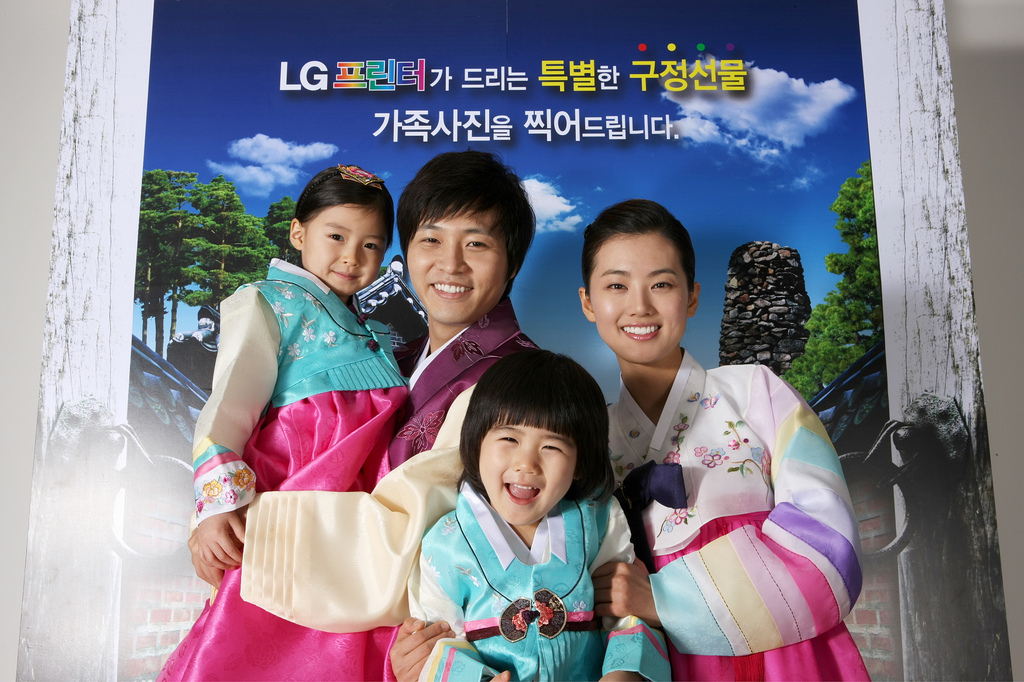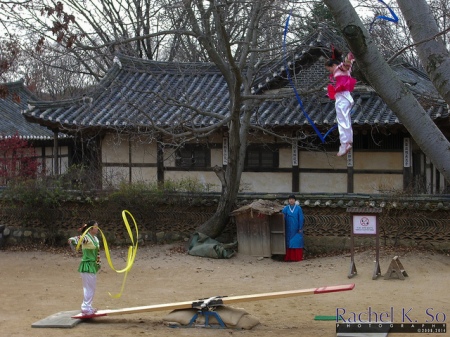What role do Neo-Confucian notions of the “life force” (ki) play in buttressing modern Korean patriarchy?
 (Warm Nest by Eugenia Loli; CC BY-NC 2.0)
(Warm Nest by Eugenia Loli; CC BY-NC 2.0)
Many years ago,Taeyeon Kim’s “Neo-Confucian Body Techniques: Women’s Bodies in Korea’s Consumer Society” was my Communist Manifesto of Korean gender relations. It was short, to the point, and instantly melded everything I knew about the subject into a simple, coherent narrative. It didn’t galvanize me into taking up arms against the bourgeoisie exactly, but it did encourage me to study more, ultimately leading to this blog. Take these quick excerpts to see why:
First, from page 99 (references removed; italics in original):
“To understand the Neo-Confucian body, it is essential to understand the concept of ki. A material force which links the body and mind into one system, ki flows through all things, giving them form and vitality….There is no distinction between the self and the universe. Neo-Confucian men were encouraged to let go of ego and become selfless, that is to have no consciousness of an individual and separate self apart from others….Ki was passed from parent to child throughout the generations, acting as a material link between ancestors and descendants….The family composed a unified body through ki, and the identity of the family and self and family was continuous and undifferentiated.”
Then, from page 100 (ditto):
Neo-Confucian scholars considered women to have inferior ki to that of men. This notion continues to be held today. One study of a village in Korea found that women were believed to be inferior to men because they did not carry the life-giving force (ki) that men did. Women were believed to be passive receptacles of the life which men implanted in them; they played no active part in creating life. Such incubation was perhaps the most important role of a woman’s body in Korea. Her body was a vessel through which the male line and ki could be perpetuated. As such, the most important physical traits for a woman were features that revealed her potential to bear children—particularly boys. “During the Yi [Choson] Dynasty, the attribute valued above all others in a prospective bride was her potential capacity to bear sons. Compared to this, her beauty and wealth were secondary.”
Upon reading that, suddenly I saw a Matrix-like ki (기) pervading everything, providing the ideological bedrock to the many, blatantly patriarchal aspects of Korean society. For instance: Koreans’ preference for sons and consequent sex ratio problem (resolved, but with a legacy of an excess of increasingly misogynistic 20-something men); the hoju system (호주제), only abolished in 2008, under which only fathers or husbands could be heads and/or legal representatives of a family; the traditional (and still prevailing) custom of only having men perform jesa (제사), or ancestor worship rights, and usually only at the eldest son’s home; and Korea’s extremely low adoption rates, with 70% of those that are adopted domestically are girls. Indeed, as The Economist explains of that last:
Traditional Confucian notions of the bloodline family still hold sway, as do aspects of primogeniture. Women who cannot bear children face strong social stigma, as do orphans and adoptees, whose chances of getting a job and marrying are limited. Many adoptions in South Korea are concealed from family and friends—and, in many cases, the adopted child. Parents ensure that the baby’s blood type matches their own; some mothers even fake pregnancy. All this sends the message that adoption is shameful, in turn discouraging more of it. The secrecy also explains why 95% of infants adopted within South Korea are less than one-month old: young enough to be passed off as biological children. A majority of adopted babies are girls so as to avoid difficulties over inheritance and at ancestral family rites, which are normally carried out by bloodline sons.
 (Source: Netizenbuzz)
(Source: Netizenbuzz)
Of course, ultimately I did realize that ki didn’t explain all that much actually. That, alas, Korean gender relations remained a messy subject, and that I still have a lifetime of learning about it ahead of me. But I hadn’t come across anything to challenge Taeyeon Kim’s characterization of the concept either, so I retained my lingering affection for it.
Then I listened to an episode about eunuchs on the BBC Radio 4 podcast In Our Time, hosted by Melvyn Bragg. That week, it featured Michael Hoeckelmann talking about eunuchs in China, Karen Radner about them in the Assyrian Empire, and Shaun Tougher in the Roman one. Jumping ahead to the sections which made do a double-take (several, in fact, as I’m sure they will to you too):
11:20
Michael Hoeckelmann) Most eunuchs came from the lower strata of society. So, if not the eunuch himself had decided to undergo castration—there are some cases in Chinese history where some eunuchs are known to have castrated themselves—then the decision rested with the family. So families that could not afford the Confucian education that was necessary and required for [a career in officialdom], they would decide to have one of their sons castrated, and to send him into the palace, in the hope that once he rose to a considerable position of power he would help his own family, his own kin.
26:36
Karen Radner) [The eunuchs, unlike] all the other people in Assyria, did not identify themselves with reference to their father’s name. Everyone else was such and such son of such and such, they were not. That’s very important. Also, as we’ve already discussed, a key attraction [for the royal family] is that they cannot father children; that’s hugely important in a society where the existence of the family across generations is one of the key incentives of human life…you achieved eternal life by having children who would invoke your name in regular rituals. Obviously that couldn’t happen with a eunuch…the royal family instead took on that responsibility. One can describe the eunuchs almost as adopted children of the royal family.
Melvyn Bragg)…But then what happened in China, as you began to say Michael, the eunuchs began to adopt children in order that these children would do exactly as Karen was saying—have prayers or whatever…ceremonies after their death to keep them alive as their ancestors.
Michael Hoeckelmann) Yes, indeed. And just as Karen was saying, like in ancient Assyria, kinship and family was all important in China…and when eunuchs were castrated they even kept what was formerly attached to their bodies in order to be buried with them (the so-called “Three Treasures”) kept in a jar because they had to show them to regulators at the imperial court. Anyway, so the eunuchs start to adopt children at a very early stage in order to bequeath their property and in order to continue the family line. Because what they had done, or what had been done to them—the castration—was actually a breach of filial piety; they were not able to continue the family line…at least not biologically.
I know what you’re thinking: Ancient China is not Korea. Also, if Taeyeon Kim’s definition of ki has substance to it (and, my youthful naivety aside, there’s still no reason to suppose otherwise), then it’s difficult to believe that it hasn’t very much provided an ideological buttress to various aspects of Korean patriarchy today. And probably in China also, where, among other things, boys command a price twice that of girls in the lucrative trade in kidnapped children.
But, if it turns out that in Korea too, jesa was and/or is more important than continuing ki—indeed, really quite separate and distinct from it—then I’m still left feeling a little chastised that I came to accept something so readily without examining it properly, simply because it provided a handy, scholarly confirmation of my pre-existing views.
But what you’ve also probably thinking is that Taeyeon Kim is just one source. And, although I’ve read more about Neo-Confucianism since then, most recently The Sage and the Second Sex: Confucianism, Ethics, and Gender edited by Li Chenyang (2000), I have to admit I’ve read nothing about ki specifically. So, on that note, let me end this post with not a revelation sorry, but a), if nothing else, a link to a very interesting podcast for you to take away from it; and b), my again posing the question provided in the introduction: what role, if any, do Neo-Confucian notions of ki play in modern Korean patriarchy?
Thanks in advance to any more learned readers than I who can provide any clarification, and/or suggest links or books for further reading. Also, please feel free to raise just about anything (Neo)-Confucianism-related in the comments, including any interesting stories about what your Korean family and/or friends do during Chuseok or Seolnal, and their attitudes towards the notion of women performing jesa. Thanks!
Related Posts:
- Women’s Bodies in Korea’s Consumer Society, Part 1: Their Neo-Confucian Heritage
- Women’s Bodies in Korea’s Consumer Society, Part 2: We’re not in Kansas Anymore
- Women’s Bodies in Korea’s Consumer Society, Part 3 (Final): Nation, Family, Self
- Reframing the Korean Plastic Surgery Debate pt. 3: Modern History, Traditional Culture
- Gender Issues and Confucian Scriptures: Is Confucianism Incompatible with Gender Equality in South Korea? (Free registration required)



 With that background and strong inclination however, there is always a danger of taking similarities as a given. And particularly in this case, where the authors of the study point out that:
With that background and strong inclination however, there is always a danger of taking similarities as a given. And particularly in this case, where the authors of the study point out that:














